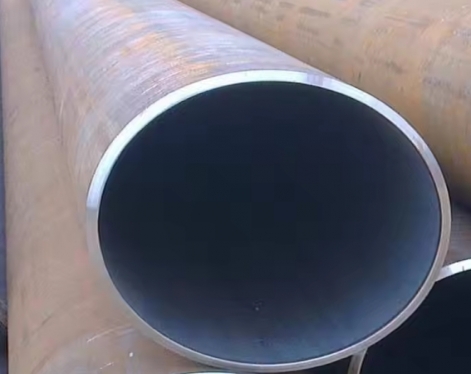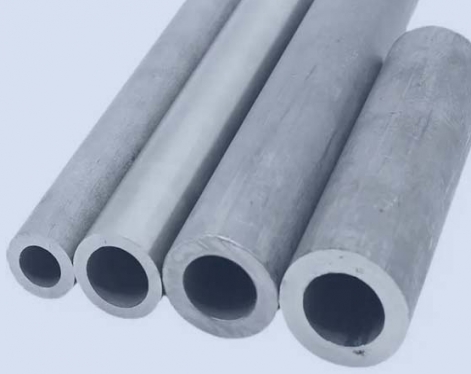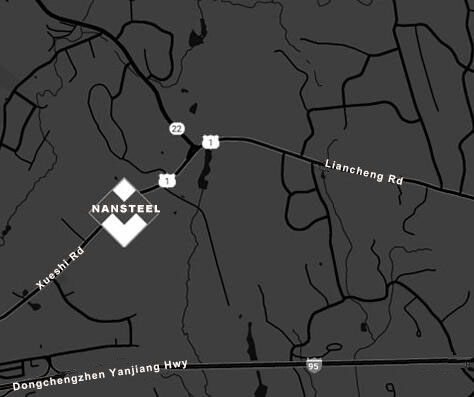Large-diameter seamless pipes have two key features: one is "large-diameter", which means a larger diameter; the other is "seamless", which means there is no weld on the entire pipe body. This type of steel pipe is made by perforating a whole round steel bar. According to different production methods, it can be divided into hot-rolled pipes, cold-rolled pipes, cold-drawn pipes, extruded pipes, etc.
Large-diameter seamless pipes, due to their seamless characteristics, can withstand greater pressure and temperature, greatly reducing the risk of leakage. Because of this, it plays a key role in many fields that require extremely high security and stability. In the extraction and transportation of oil and natural gas, it ensures stable transmission of energy; In the chemical industry, it is used to transport various corrosive chemicals; in the electric power industry, key parts such as high-pressure boilers and steam pipes are also inseparable from it.
Measures to ensure the quality and safety of large-diameter seamless pipes
1. Production process control:
Raw material selection: Select high-quality steel billets that meet the standards and conduct strict incoming inspections, including chemical composition analysis, metallographic inspection, etc., to control quality from the source.
Smelting process: Use advanced smelting technology, such as refining outside the furnace, vacuum degassing, etc. to reduce the impurity content in the steel, improve the purity of the steel, accurately control various parameters in the smelting process, and ensure the uniformity and stability of the molten steel composition.
Piercing and rolling: Use advanced piercing and rolling equipment and processes to control key parameters such as rolling temperature and deformation to avoid defects such as cracks, folding, and uneven wall thickness. For large-diameter steel pipes, processes such as oblique piercing and multi-stand rolling are usually used.
Heat treatment: Select appropriate heat treatment process according to steel type and purpose, such as normalizing, annealing, quenching + tempering, etc., to improve the organizational structure and mechanical properties of the steel pipe and eliminate internal stress.
Finishing: The steel pipe is subjected to finishing processes such as straightening, cutting the heads and tails, and chamfering to ensure the dimensional accuracy and appearance quality of the steel pipe.
2. Quality Inspection:
Chemical composition analysis: The chemical composition of the finished steel pipe is analyzed. Commonly used methods include spectral analysis and chemical analysis to ensure that it meets the standard requirements.
Mechanical properties test: Conduct tensile test, impact test, hardness test, etc. to check whether the mechanical properties of the steel pipe, such as strength, toughness and hardness, are qualified.
Metallographic inspection: Observe the metallographic structure of the steel pipe to determine whether there are defects, such as coarse grains, banded structure, inclusions, etc.
Non-destructive testing (NDT): Use ultrasonic testing, eddy current testing, magnetic particle testing, X-ray testing and other non-destructive testing methods to detect defects inside and on the surface of steel pipes, such as cracks, pores, slag inclusions, etc. Non-destructive testing is particularly important for large-diameter thick-walled steel pipes.
Water pressure test: Conduct water pressure test on steel pipes to check their pressure bearing capacity and sealing performance.
Dimension inspection: Use measuring tools such as vernier calipers and micrometers to accurately measure the outer diameter, inner diameter, wall thickness, length and other dimensions of the steel pipe to ensure that it meets the standard requirements.
Third-party testing: An independent third-party testing agency can be entrusted to conduct testing to ensure the fairness and authority of the test results.

3. Standards and specifications:
Implementation of relevant standards: Strictly implement relevant national standards, industry standards and enterprise standards, such as GB/T 8162 (seamless steel pipes for structures), GB/T 8163 (seamless steel pipes for conveying fluids), API 5L (pipeline steel pipe specifications), etc.
Establish a quality management system: Establish and effectively operate quality management systems such as ISO 9001 to standardize production processes and quality control procedures.
4. Transportation and storage:
Transportation: Use appropriate transportation methods and tools to prevent the steel pipes from being damaged by collision, extrusion, etc. during transportation.
Storage: Store the steel pipe in a dry and ventilated place to avoid moisture and corrosion, and take necessary anti-rust measures such as oiling, covering, etc.
5. Safety measures during use:
Design: During the pipeline and structure design stage, fully consider factors such as the pressure bearing capacity and working environment of the steel pipe, and select appropriate steel pipe specifications and materials.
Installation: Install strictly in accordance with relevant construction specifications to ensure that the connection between pipelines and structures is firm and reliable.
Operation and maintenance: Regularly inspect and maintain pipelines and structures to promptly identify and address potential safety hazards.
Safety operating procedures: Develop comprehensive safety operating procedures and provide training to operators to enhance safety awareness.
Special considerations for large-diameter seamless pipes
Wall thickness uniformity control: It is difficult to control the wall thickness uniformity of large-diameter steel pipes, and more advanced production processes and control methods are required.
Welding quality control: If welding is required, appropriate welding processes and materials need to be used, and strict post-weld inspections need to be carried out to ensure the quality of the weld.
Transportation and hoisting safety: Large-diameter steel pipes are heavy, and special safety measures need to be taken during transportation and hoisting to prevent accidents.
Read more: Reasons for magnetic properties of large diameter seamless steel pipe
Large-diameter seamless pipes, due to their seamless characteristics, can withstand greater pressure and temperature, greatly reducing the risk of leakage. Because of this, it plays a key role in many fields that require extremely high security and stability. In the extraction and transportation of oil and natural gas, it ensures stable transmission of energy; In the chemical industry, it is used to transport various corrosive chemicals; in the electric power industry, key parts such as high-pressure boilers and steam pipes are also inseparable from it.
Measures to ensure the quality and safety of large-diameter seamless pipes
1. Production process control:
Raw material selection: Select high-quality steel billets that meet the standards and conduct strict incoming inspections, including chemical composition analysis, metallographic inspection, etc., to control quality from the source.
Smelting process: Use advanced smelting technology, such as refining outside the furnace, vacuum degassing, etc. to reduce the impurity content in the steel, improve the purity of the steel, accurately control various parameters in the smelting process, and ensure the uniformity and stability of the molten steel composition.
Piercing and rolling: Use advanced piercing and rolling equipment and processes to control key parameters such as rolling temperature and deformation to avoid defects such as cracks, folding, and uneven wall thickness. For large-diameter steel pipes, processes such as oblique piercing and multi-stand rolling are usually used.
Heat treatment: Select appropriate heat treatment process according to steel type and purpose, such as normalizing, annealing, quenching + tempering, etc., to improve the organizational structure and mechanical properties of the steel pipe and eliminate internal stress.
Finishing: The steel pipe is subjected to finishing processes such as straightening, cutting the heads and tails, and chamfering to ensure the dimensional accuracy and appearance quality of the steel pipe.
2. Quality Inspection:
Chemical composition analysis: The chemical composition of the finished steel pipe is analyzed. Commonly used methods include spectral analysis and chemical analysis to ensure that it meets the standard requirements.
Mechanical properties test: Conduct tensile test, impact test, hardness test, etc. to check whether the mechanical properties of the steel pipe, such as strength, toughness and hardness, are qualified.
Metallographic inspection: Observe the metallographic structure of the steel pipe to determine whether there are defects, such as coarse grains, banded structure, inclusions, etc.
Non-destructive testing (NDT): Use ultrasonic testing, eddy current testing, magnetic particle testing, X-ray testing and other non-destructive testing methods to detect defects inside and on the surface of steel pipes, such as cracks, pores, slag inclusions, etc. Non-destructive testing is particularly important for large-diameter thick-walled steel pipes.
Water pressure test: Conduct water pressure test on steel pipes to check their pressure bearing capacity and sealing performance.
Dimension inspection: Use measuring tools such as vernier calipers and micrometers to accurately measure the outer diameter, inner diameter, wall thickness, length and other dimensions of the steel pipe to ensure that it meets the standard requirements.
Third-party testing: An independent third-party testing agency can be entrusted to conduct testing to ensure the fairness and authority of the test results.

3. Standards and specifications:
Implementation of relevant standards: Strictly implement relevant national standards, industry standards and enterprise standards, such as GB/T 8162 (seamless steel pipes for structures), GB/T 8163 (seamless steel pipes for conveying fluids), API 5L (pipeline steel pipe specifications), etc.
Establish a quality management system: Establish and effectively operate quality management systems such as ISO 9001 to standardize production processes and quality control procedures.
4. Transportation and storage:
Transportation: Use appropriate transportation methods and tools to prevent the steel pipes from being damaged by collision, extrusion, etc. during transportation.
Storage: Store the steel pipe in a dry and ventilated place to avoid moisture and corrosion, and take necessary anti-rust measures such as oiling, covering, etc.
5. Safety measures during use:
Design: During the pipeline and structure design stage, fully consider factors such as the pressure bearing capacity and working environment of the steel pipe, and select appropriate steel pipe specifications and materials.
Installation: Install strictly in accordance with relevant construction specifications to ensure that the connection between pipelines and structures is firm and reliable.
Operation and maintenance: Regularly inspect and maintain pipelines and structures to promptly identify and address potential safety hazards.
Safety operating procedures: Develop comprehensive safety operating procedures and provide training to operators to enhance safety awareness.
Special considerations for large-diameter seamless pipes
Wall thickness uniformity control: It is difficult to control the wall thickness uniformity of large-diameter steel pipes, and more advanced production processes and control methods are required.
Welding quality control: If welding is required, appropriate welding processes and materials need to be used, and strict post-weld inspections need to be carried out to ensure the quality of the weld.
Transportation and hoisting safety: Large-diameter steel pipes are heavy, and special safety measures need to be taken during transportation and hoisting to prevent accidents.
Read more: Reasons for magnetic properties of large diameter seamless steel pipe









